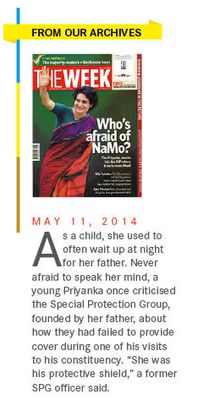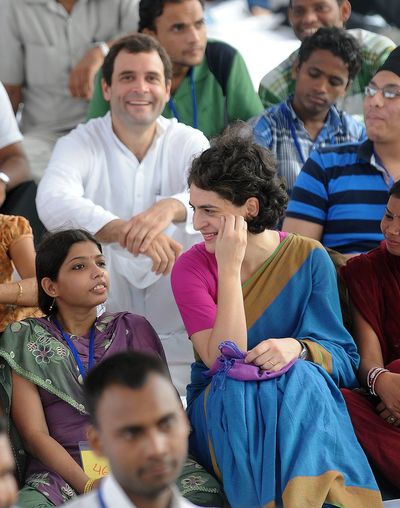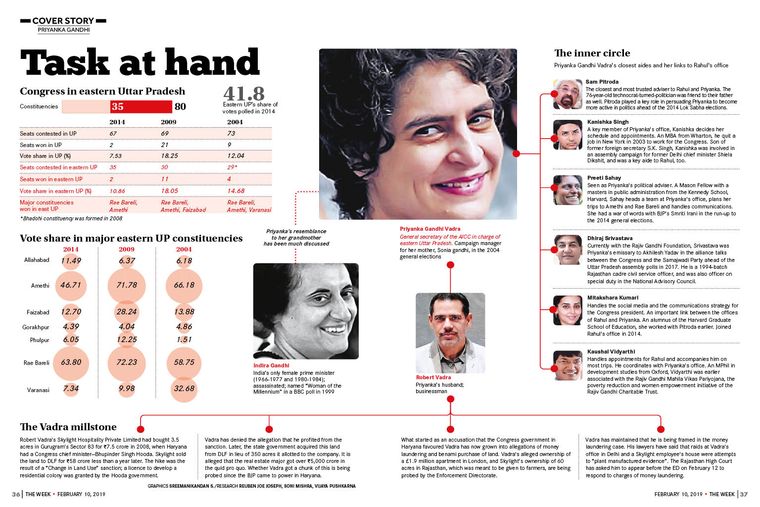It was perhaps the most awaited political debut. And, somehow inevitable. Just two months ahead of the Lok Sabha elections, Priyanka Gandhi Vadra has—after more than two decades of speculation—finally taken the political plunge. She has become the Congress general secretary in charge of eastern Uttar Pradesh, a state that sends 80 members to the Lok Sabha.
For party workers, she was always a natural-born politician who could disarm people with her charm. More importantly, they saw in her her grandmother, Indira Gandhi. She looked similar, dressed like her and even had similar mannerisms.
Back in 1999, impressed by her campaign in Amethi and Rae Bareli, Congress leaders requested her mother Sonia Gandhi to launch her in the Lok Sabha elections, that too against the towering Atal Bihari Vajpayee in Lucknow. It was a no from the Gandhi family. The leaders repeated their request in 2004, only to be turned down again. They kept at it, every time the Congress failed at the hustings. But, Priyanka did not cave in. She restricted herself to campaigning for her mother and brother, Rahul, in Rae Bareli and Amethi.
But now, the Congress has finally launched its brahmastra, as the 47-year-old is known in the party, and her reputation precedes her arrival. Congress managers in Amethi and Rae Bareli speak about her remarkable connect with the people and party workers. Once, during the 2009 Lok Sabha election campaign, Priyanka got news of an accident involving her cavalcade, in which some people in a van were hurt. She immediately cancelled the day’s schedule and went to meet the injured.
A family friend shared another anecdote that highlighted her warmth and people skills. “Once, a Congress leader and his son came to meet her,” said the friend. “The son wanted to take a picture with Priyanka. She smiled throughout. She knew what was going on. But she put her arm around the boy’s shoulders for the picture.”
Priyanka’s persona is also defined by two grand gestures of forgiveness. Her meeting with Nalini Sriharan, an accused in the assassination of her father Rajiv Gandhi, in jail, and her initiative to mend ties with her estranged uncle Arun Nehru. She had taken Sonia and Rahul to meet an ailing Nehru in a Gurugram hospital in 2013, and her son, Raihan, performed his last rites.
“I think she is the finest woman I know of her generation in the country,” said architectural conservationist Sunita Kohli, a family confidante. “She has extraordinary qualities of the head and heart.”
Add to that her ability to think on her feet, said party workers. “When Soniaji came to file her nomination papers from Amethi in 1999, a huge crowd gathered outside the sub-divisional magistrate’s office, and the media could not enter,” recalls a party leader. “Priyanka noticed it and discreetly asked an official to do the needful. The media was let in.”
Then, in 2004, she again showed quick thinking and initiative. A few women died in a stampede at a sari-distribution function the BJP held in Lucknow. Rahul told his aides that he did not want to politicise the incident. But Priyanka reacted saying it was a violation of the model code of conduct.
“Priyanka reminds one of her grandmother,” said political expert Professor Ram Bahadur Verma. “She has the same temperament, the same image, the same aggression. She is not defensive like Rahul. And her Hindi is effortless.”
Though she did not contest herself, Priyanka did step up her political involvement before the 2014 Lok Sabha elections. She became a back-room strategist for Rahul. And, in the following years, she became part of the party’s decision-making process. Apparently, when the alliance talks with the Samajwadi Party hit a roadblock ahead of the 2017 Uttar Pradesh assembly elections, she called up Dimple Yadav, the wife of Samajwadi Party president Akhilesh Yadav, and dissolved tensions. The deal was soon finalised.
In the run-up to the Uttar Pradesh elections, there was speculation on whether Priyanka would be made the party’s chief minister candidate. Prashant Kishor, then election strategist for the Congress, had made the suggestion, but Priyanka declined.
The same year, before the Punjab assembly elections, cricketer-turned-politician Navjot Singh Sidhu had been keeping the Congress on tenterhooks, dropping hints about joining the Aam Aadmi Party. Priyanka spoke to him and got him on board. In what was expected to be a close election, Sidhu’s presence helped the Congress.
And now that she has taken on a more direct role, the party has high hopes. In fact, almost immediately after the announcement of her new assignment, there were posters in Varanasi and Gorakhpur, demanding that she contest from there. There is an expectation that she would take on Prime Minister Narendra Modi and Chief Minister Yogi Adityanath, which seems to have enthused party workers. “She is quite capable of giving it back to Modi, as she showed in 2014, when she responded directly to his barbs,” said Uttar Pradesh Congress leader Akhilesh Pratap Singh. “When she campaigns extensively in this region, it will definitely have a huge impact in Varanasi. Modi will be tied down to his constituency. And when this is amplified by 24x7 television, its impact will be felt beyond the state. Priyankaji will overshadow Modi on television.”
Keeping hype aside, making an electoral impact would be a huge task for Priyanka. Though the Congress won more than half of its 21 seats in the 2009 Lok Sabha elections from eastern Uttar Pradesh, it got only Amethi and Rae Bareli in 2014.
Granted, Priyanka can draw crowds, but getting them into booths requires a lot more than charisma. The main difference between 2009 and 2019 is that the former was a four-cornered contest, while the latter is seen as a head-to-head battle between the BJP and the Samajwadi Party-Bahujan Samaj Party alliance. So, while there is a dalit-Muslim-OBC consolidation on one side, the BJP is shoring up its upper caste support base on the other. In this situation, the Congress, a weakened force in the state and with no dedicated vote bank, can make little impact. “In 2009, the Congress had polled 18.5 per cent votes and won 21 seats,” said political scientist Abhay Kumar Dubey. “In this election, however, the votes are polarised. The Congress needs to poll more than 23 to 24 per cent votes to get seats on its own. This is beyond its organisational capability.”
Plan Priyanka, however, is backed by some hard-nosed calculations. The Congress, shut out of the opposition alliance in the state, feels that the arrival of Priyanka could lead to an unannounced understanding with Akhilesh and Mayawati in seats where the Congress is better placed to defeat the BJP. The Brahmin voter—said to be unhappy with the Rajputs getting preference under Adityanath—is on the Congress radar. If there is backing from the other parties, the Congress can hope for support from dalits and Muslims, too.
“People in general and even the workers of the SP and the BSP have said that this (Priyanka’s political plunge) will make a lot of difference,” said Congress leader Annu Tandon. “That this will bring in energy into the campaign, and they have a lot of faith in her. They see her as one of their own.”
Also, the Congress would hope to win over caste-based groups such as the Rajbhars, or the faction of the Apna Dal that is opposed to the BJP, to widen its OBC voter base.
“She has already made an impact,” said former BJP leader Yashwant Sinha. “And when she actively campaigns, there will be a greater impact.”
The Congress seems confident of giving the BJP a fight in 15 constituencies, many of which are in eastern Uttar Pradesh. These seats, where the party had polled more than one lakh votes each in 2014, include Dhaurahra, once represented by Jitin Prasada; Unnao, being nurtured by former MP Annu Tandon; Barabanki, which had sent P.L. Punia to the Lok Sabha; Kushinagar, the constituency of R.P.N Singh; Kanpur, where Sriprakash Jaiswal is a formidable name; Pratapgarh, from where Rajkumari Ratna Singh won in 2009; and Faizabad, from where former state president Nirmal Khatri had once contested.
“The situation in Uttar Pradesh is challenging,” said Prasada. “But Priyankaji has accepted that challenge. It is a big thing. She will deal with the challenge head-on and will lead from the front. She comes with a lot of experience of politics in this region, having had a role in Amethi and Rae Bareli, so she is aware of what the cadre wants and the expectations of the people.”
Priyanka is expected to focus on the unfulfilled promises of the National Democratic Alliance government, be it the farmers’ issues or unemployment. She is also expected to talk about the deteriorating law and order situation in the state and women’s empowerment. A Congress leader said the aim will be to project the party as a viable alternative to the BJP, as a party that stands for progressive politics.
Professor Ram Kishore Shastri, a political expert from Amethi, said Priyanka would have to reactivate the organisation, and bring people back into the Congress fold. “Party workers are political creatures,” he said. “If the party is not politically active, they will leave. The dalits went to the BSP, and the Muslim supporters went to the SP.”
There is also talk of whether Priyanka will campaign outside Uttar Pradesh, especially in the southern states where the memory of Indiramma, as her grandmother was fondly called, is still vivid. Apparently, the option has been kept open. The Congress believes that Priyanka’s impact at the national level will be decided by her performance in eastern Uttar Pradesh.
And while there is a debate on the possibility of Priyanka eclipsing Rahul, party leaders say the leadership issue is settled now, especially after the recent wins in three Hindi heartland states, and with Rahul’s persistent attacks on Modi.
For a long time, a theory floated in political circles was that allegations of corruption against Robert Vadra, Priyanka’s businessman husband, had deterred her from taking the plunge. He was described as her Achilles heel, and the BJP often brought up the charges against Vadra (see graphics). Vadra’s flashy lifestyle and his Page-3 presence did not complement the image of simplicity the Gandhis projected.
While the BJP is expected to target Vadra again, Priyanka is likely to answer aggressively, like she did in the run-up to the 2014 Lok Sabha elections.
The BJP would also talk of dynastic politics, pitting Modi’s humble origins against the privileged background of Rahul and Priyanka. “This talk about dynastic politics will not work with the people,” said Congress leader J.K. Jain, an Indira confidant. “They remember the Gandhi family’s sacrifices. It is not easy for them to enter politics after the tragedies that have struck the family.”
Priyanka had once said that she got Indira’s saris altered to fit her, as her grandmother was shorter than her. Evidently, for all their similarities, there are differences, too. For instance, their political challenges. While Indira worked to keep the Congress on top, Priyanka now has to bring it up from the bottom.





